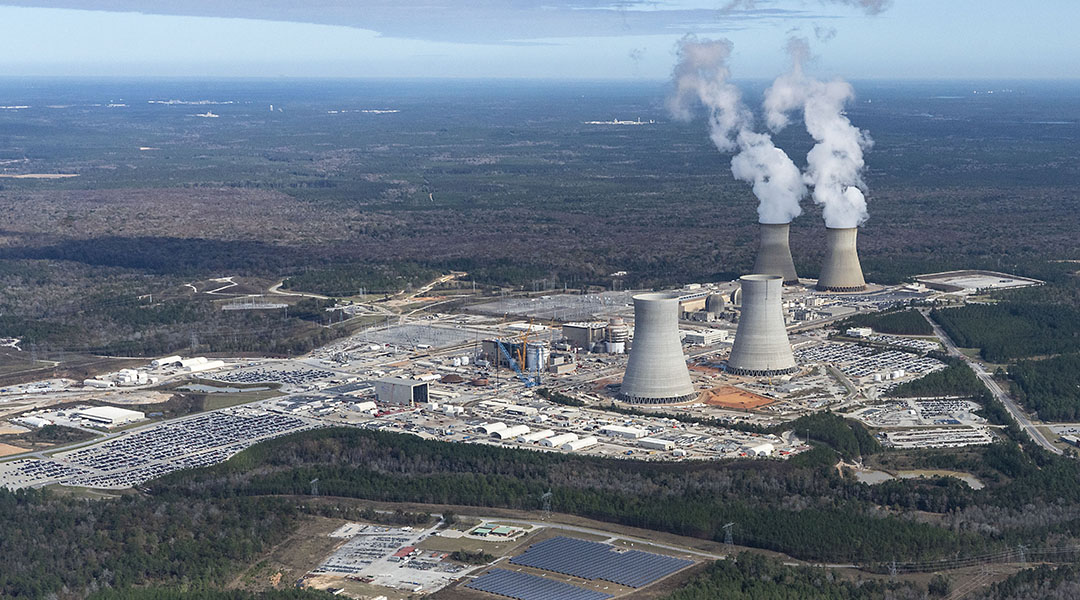Vogtle nuclear power plants. Image credit: Tim Mousseau ©2020
In December 2021, the government of Belgium joined an increasing number of countries expressing an interest in building what are called small modular reactors, which generate under 300 megawatts of electrical power — much smaller than the 1000 to 1700 megawatts typical of large reactors that dominate today’s nuclear power landscape.
Belgium’s interest in small modular reactors was paired with a decision to phase out the country’s operating nuclear power plants by 2025, with Prime Minister Alexander De Croo declaring that the decision amounted to bidding goodbye to the old nuclear reactors but looking to nuclear energy of the future.
Does replacing ageing nuclear capacity with these smaller reactors make economic sense and will it happen?
Belgium is hardly alone in being interested in small modular reactors. At the forefront of efforts to commercialize these designs are the governments of the U.S., the U.K., and Canada, all of which provide large amounts of taxpayer money to subsidize their development. These three countries have long histories in nuclear power and are influencing other countries to follow their lead.
Decline in nuclear power
The background to interest in small reactors is the consistently declining share of nuclear power in global electricity generation, from 17.5% in 1996 to around 10% in 2020. This decline reflects the steep falloff in orders for nuclear power from the mid-1980s onward.
Although often blamed on public opposition to nuclear power, especially resulting from the devastating accidents at Chernobyl and Fukushima, the main cause for the drop in nuclear power’s importance has been the steadily rising cost of nuclear reactors and the almost invariable tendency for project construction costs and time to escalate dramatically.
An illustration is the Vogtle project in the U.S. state of Georgia, where two large 1100 megawatt AP1000 reactors are being constructed. These two reactors are among approximately 30 new reactor proposals announced after the U.S. government offered handsome financial incentives for nuclear power plant construction in 2005. Of these, only four reactors moved to the construction stage.
The other project was in the nearby state of South Carolina and also involved two AP1000 reactors. After $9 billion was spent on this project, the utility company abandoned construction in 2017 because capital costs and building schedules had escalated beyond control.
Construction of the Vogtle reactors continues despite the project cost increasing from an initial estimate of $14 billion to over $30 billion, and the plant is still at least two years from completion. This is typical of such projects, and the poor construction record has made nuclear power plants difficult to finance because financiers are unwilling to be exposed to these risks.
The economic challenges of small reactors
Advocates for small modular reactors claim that this strategy will lower costs in the long run. They blame rising costs and delays on the size and complexity of large reactors and on the difficulty in managing the large amount of work they need to construct on-site. Small modular reactors are expected to be cheaper because they will use production line-made modules that will require much less work at the site.
These arguments have superficial attractions and do not stand up to scrutiny. The main strategy for combating nuclear power’s historic lack of competitiveness has been to build ever-larger reactors because the expenses associated with constructing and operating a reactor should not increase in direct proportion to the power generated. Small modular reactors cannot defy this economic logic. The scale economies that will be lost cannot be compensated for by factory manufacturing, and they will cost more than large reactors for each unit (megawatt) of generation capacity.
Experience also suggests that factory manufacturing of modules will not be a panacea. The AP1000 design used at the Vogtle and Summer sites relied heavily on using modular factory-made components, but that reliance did not prevent the large cost and time overruns as well as quality problems that have bedeviled these projects.
There is also a “Catch 22”. The economics will only be tested when large numbers of reactors manufactured on production lines have been built and their cost known. Private industry is not going to take the risk of paying for production lines and buying large numbers of reactors that could well prove uneconomic. So, it will be public money, as it nearly always has been the case with nuclear power, that will be risked.
Renewables are a better alternative
Whether small modular reactors can beat large reactors in terms of economics is not the issue; it is their competitiveness with renewables. While nuclear costs have been relentlessly rising for decades, costs of renewables have plummeted and are now far lower than for nuclear. In its most recent estimate, the Wall Street firm, Lazard, estimated that a new nuclear plant will generate electricity at an average cost of $167 per megawatt hour, over four times the corresponding estimates of $38 and $34 per megawatt hour for new wind and solar energy plants, respectively.
Renewables can also be deployed much quicker and more reliably than nuclear — a key factor in dealing with a climate emergency. And the myth that electrical grids cannot be operated reliably with renewables because the Sun does not shine all the time and wind does not always blow is just that: a myth. In fact, renewables can be the basis of a reliable electricity system provided suitable and affordable options, such as energy efficiency, demand response, technological and geographic diversity, and some storage, are incorporated.
The economic problems associated with small reactors means that they will not be built in large numbers, and they will not halt the decline in nuclear power. The track record in the U.S., Canada, and the U.K. so far suggests that the development efforts in these countries are unlikely to succeed. If even these countries, with their long history of exploiting nuclear power and large financial and skills resources cannot commercialize these technologies, then the prospects in other countries will also be bleak.
All of this can be ignored but for the “opportunity costs” of pursuing small modular reactors. Throughout nuclear power’s history, governments have continually believed that nuclear power would solve the energy problems of the day, whether it is dependence on hostile suppliers of oil and gas, acid rain, or now, climate change.
This belief has resulted in grossly over-optimistic and unfulfilled forecasts of nuclear expansion. The attempt has diverted money and resources away from the options that would have addressed these issues. If governments continue to pursue small reactors, this will jeopardize our attempts to mitigate climate change.
Written by: M. V. Ramana and Stephen Thomas
Reference: Stephen Thomas and M. V. Ramana, A Hopeless Pursuit? National Efforts to Promote Small Modular Nuclear Reactors and Revive Nuclear Power, WIRES Energy and Environment (2022). DOI: 10.1002/wene.429

















